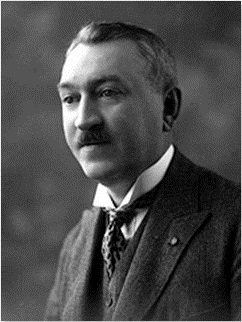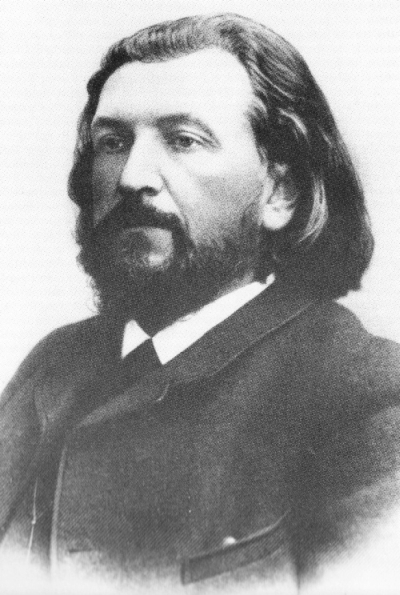|
Nicolai Tcherepnin
Nikolai Nikolayevich Tcherepnin (Russian: Николай Николаевич Черепнин; – 26 June 1945) was a Russian composer, pianist, and conductor. He was born in Saint Petersburg and studied under Nikolai Rimsky-Korsakov at the Saint Petersburg Conservatory. He conducted for the first Paris season of Sergei Diaghilev's Ballets Russes. Life Nikolai Tcherepnin was born in 1873 to a well-known and wealthy physician of the same name. The elder Nikolai moved in elite circles of artists including Fyodor Dostoyevsky and Modest Mussorgsky. Young Nikolai's mother died when he was a baby, and when his father remarried, was replaced by an ambivalent stepmother. As a child, Nikolai's father beat him regularly and enforced a general code of strict discipline. At his father's insistence, Nikolai earned a law degree, though during this time he composed steadily. In 1895 he graduated with his degree in law from the University of Saint Petersburg. In 1898, he earned a degre ... [...More Info...] [...Related Items...] OR: [Wikipedia] [Google] [Baidu] |
Lazare Saminsky
Lazare Saminsky, born Lazar Semyonovich Saminsky (russian: Лазарь (Элиэзер) Семенович Саминский; Valehotsulove (now Dolynske), near Odessa, 27 October 1882 O.S. / 8 November N.S. – Port Chester, New York, 30 June 1959), was a performer, conductor and composer, especially of Jewish music. Life Born to a merchant family, Saminsky received a broad education in the arts, sciences and languages. He studied music at the Odessa conservatoire from 1903–1905, and then went to Moscow, where he studied mathematics and philosophy as well as music. Expelled for his participation in the student protests of 1905, he went to St.Petersburg, where he studied with Nikolai Rimsky-Korsakov, Anatoly Lyadov, and Nikolai Tcherepnin. While still a student he became a founder member, with Mikhail Gnesin, Lyubov Streicher, and others, of the 'Society for Jewish Folk Music'. He wrote music for the Society and helped organise its earliest publication. He continued an a ... [...More Info...] [...Related Items...] OR: [Wikipedia] [Google] [Baidu] |
Monte Carlo
Monte Carlo (; ; french: Monte-Carlo , or colloquially ''Monte-Carl'' ; lij, Munte Carlu ; ) is officially an administrative area of the Principality of Monaco, specifically the ward of Monte Carlo/Spélugues, where the Monte Carlo Casino is located. Informally, the name also refers to a larger district, the Monte Carlo Quarter (corresponding to the former municipality of Monte Carlo), which besides Monte Carlo/Spélugues also includes the wards of La Rousse/Saint Roman, Larvotto/Bas Moulins and Saint Michel. The permanent population of the ward of Monte Carlo is about 3,500, while that of the quarter is about 15,000. Monaco has four traditional quarters. From west to east they are: Fontvieille (the newest), Monaco-Ville (the oldest), La Condamine, and Monte Carlo. Monte Carlo is situated on a prominent escarpment at the base of the Maritime Alps along the French Riviera. Near the quarter's western end is the "world-famous Place du Casino, the gambling center ... that has ... [...More Info...] [...Related Items...] OR: [Wikipedia] [Google] [Baidu] |
Berlin
Berlin ( , ) is the capital and largest city of Germany by both area and population. Its 3.7 million inhabitants make it the European Union's most populous city, according to population within city limits. One of Germany's sixteen constituent states, Berlin is surrounded by the State of Brandenburg and contiguous with Potsdam, Brandenburg's capital. Berlin's urban area, which has a population of around 4.5 million, is the second most populous urban area in Germany after the Ruhr. The Berlin-Brandenburg capital region has around 6.2 million inhabitants and is Germany's third-largest metropolitan region after the Rhine-Ruhr and Rhine-Main regions. Berlin straddles the banks of the Spree, which flows into the Havel (a tributary of the Elbe) in the western borough of Spandau. Among the city's main topographical features are the many lakes in the western and southeastern boroughs formed by the Spree, Havel and Dahme, the largest of which is Lake Müggelsee. Due to its l ... [...More Info...] [...Related Items...] OR: [Wikipedia] [Google] [Baidu] |
Le Pavillon D'Armide
''Le Pavillon d'Armide'' is a ballet in one act and three scenes choreographed by Michel Fokine with music by Nikolai Tcherepnin to a libretto by Alexandre Benois. It was inspired by the novella ''Omphale'' by Théophile Gautier. History The work was first presented on 25 November 1907 at the Mariinsky Theatre in Saint Petersburg, with staging and costumes by Alexandre Benois. Principal dancers were Anna Pavlova in the role of Armida, Vaslav Nijinsky as her slave, and Pavel Gerdt as the Vicomte René de Beaugency. On 19 May 1909, the ballet was presented by Sergei Diaghilev's Ballets Russes at the Théâtre du Châtelet, Paris. The role of Armida was danced by Vera Karalli, the Vicomte de Beaugency by Mikhail Mordkin __NOTOC__ Mikhail Mordkin (russian: Михаил Михайлович Мордкин; December 9, 1880, Moscow, Russian Empire - July 15, 1944, New York) graduated from the Bolshoi Ballet School in 1899, and in the same year was appointed ballet ..., and the ... [...More Info...] [...Related Items...] OR: [Wikipedia] [Google] [Baidu] |
Ballet
Ballet () is a type of performance dance that originated during the Italian Renaissance in the fifteenth century and later developed into a concert dance form in France and Russia. It has since become a widespread and highly technical form of dance with its own vocabulary. Ballet has been influential globally and has defined the foundational techniques which are used in many other dance genres and cultures. Various schools around the world have incorporated their own cultures. As a result, ballet has evolved in distinct ways. A ''ballet'' as a unified work comprises the choreography and music for a ballet production. Ballets are choreographed and performed by trained ballet dancers. Traditional classical ballets are usually performed with classical music accompaniment and use elaborate costumes and staging, whereas modern ballets are often performed in simple costumes and without elaborate sets or scenery. Etymology Ballet is a French word which had its origin in Italian ... [...More Info...] [...Related Items...] OR: [Wikipedia] [Google] [Baidu] |
Alexander Ossovsky
Alexander Vyacheslavovich Ossovsky (russian: link=no, Александр Вячеславович Оссовский, July 31, 1957) was a renowned Russian musical writer, critic and musicologist, professor at Saint Petersburg Conservatory, pupil of Nikolai Rimsky-Korsakov, and friend of Sergei Rachmaninoff, Alexander Siloti and Nikolai Tcherepnin. Biography Alexander Ossovsky was born on March 31, 1871, in Kishinev, Bessarabia, Russian Empire into the family of Vyacheslav Stepanovich Ossovsky, who was a department chair in the Odessa Court; his mother was Yevgenia Cherkunova. The composer Mykola Vilinsky was his cousin. Ossovsky graduated from the Law School at Moscow University (1893). After graduation he worked at the Ministry of Justice in Saint Petersburg. From 1896 to 1898 he studied at Saint Petersburg Conservatory. From 1900 to 1902 he studied composition with the composer Nikolai Rimsky-Korsakov. In 1894 Ossovsky started his career as a talented and prolific musical wr ... [...More Info...] [...Related Items...] OR: [Wikipedia] [Google] [Baidu] |
Mir Iskusstva
''Mir iskusstva'' ( rus, «Мир искусства», p=ˈmʲir ɪˈskustvə, ''World of Art'') was a Russian magazine and the artistic movement it inspired and embodied, which was a major influence on the Russians who helped revolutionize European art during the first decade of the 20th century. The magazine had limited circulation outside Russia. From 1909, several of the ''miriskusniki'' (i.e., members of the movement) also participated in productions of Sergei Diaghilev's Ballets Russes company based in Paris. Foundation The artistic group was founded in November 1898 by a group of students that included Alexandre Benois, Konstantin Somov, Dmitry Filosofov, Léon Bakst, and Eugene Lansere. The starting moments for the new artistic group was organization of the ''Exhibition of Russian and Finnish Artists'' in the Stieglitz Museum of Applied Arts in Saint-Petersburg. The magazine was co-founded in 1899 in St. Petersburg by Alexandre Benois, Léon Bakst, and Sergei ... [...More Info...] [...Related Items...] OR: [Wikipedia] [Google] [Baidu] |
Mitrofan Belyayev
Mitrofan Petrovich Belyayev (russian: Митрофа́н Петро́вич Беля́ев; old style 10/22 February 1836, St. Petersburg22 December 1903/ 4 January 1904) was an Imperial Russian music publisher, outstanding philanthropist, and the owner of a large wood dealership enterprise in Russia. He was also the founder of the Belyayev circle, a society of musicians in Russia whose members included Nikolai Rimsky-Korsakov, Alexander Glazunov and Anatoly Lyadov. His surname is often transliterated as ''Belaieff'' or ''Belayev''. In 1886 the Russian painter Ilya Repin made a portrait of Belyayev. Biography Belyayev was the son of a rich Russian wood dealer and large land owner. Early on, he was established as a successful buyer in his father's company, whose line he took over after 30 years. His passion, at first private, was however for music. Belyayev had learned and played violin, viola and piano when in school, and played viola for many years in a string quartet. L ... [...More Info...] [...Related Items...] OR: [Wikipedia] [Google] [Baidu] |
Mariinsky Theatre
The Mariinsky Theatre ( rus, Мариинский театр, Mariinskiy teatr, also transcribed as Maryinsky or Mariyinsky) is a historic theatre of opera and ballet in Saint Petersburg, Russia. Opened in 1860, it became the preeminent music theatre of late 19th-century Russia, where many of the stage masterpieces of Tchaikovsky, Mussorgsky, and Rimsky-Korsakov received their premieres. Through most of the Soviet era, it was known as the Kirov Theatre. Today, the Mariinsky Theatre is home to the Mariinsky Ballet, Mariinsky Opera and Mariinsky Orchestra. Since Yuri Temirkanov's retirement in 1988, the conductor Valery Gergiev has served as the theatre's general director. Name The theatre is named after Empress Maria Alexandrovna, wife of Tsar Alexander II. There is a bust of the Empress in the main entrance foyer. The theatre's name has changed throughout its history, reflecting the political climate of the time: * 1860 – 1920: Imperial Mariinsky Theatre ( rus, Импера ... [...More Info...] [...Related Items...] OR: [Wikipedia] [Google] [Baidu] |
Ivan Vasilenko
Ivan Dmitrievich Vasilenko (russian: Ива́н Дми́триевич Василе́нко, uk, Іван Дмитрович Василенко; January 20, 1895 – May 26, 1966), was a Soviet writer of children's books. Early years Ivan Dmitrievich Vasilenko was born January 20, 1895, in the village of Makiivka, in Don Host Oblast (in present-day Donetsk Oblast, Ukraine) in a clerk’s family. Seven years later, his family moved to the city of Taganrog proper. In 1912 Ivan Vasilenko graduated from the 4-year college and became teacher at a village school. He entered the Belgorod pedagogical institute, but was soon dismissed for organization of a Marxist group, because of that the further route for Vasilenko to teaching was closed and he worked as an accountant in the Taganrog Land bank. After October Revolution, he managed trade department, later the department of public education, and gave lessons. During World War II, he contributed to Soviet military newspapers. The li ... [...More Info...] [...Related Items...] OR: [Wikipedia] [Google] [Baidu] |
Alexander Siloti
Alexander Ilyich Siloti (also Ziloti, russian: Алекса́ндр Ильи́ч Зило́ти, ''Aleksandr Iljič Ziloti'', uk, Олександр Ілліч Зілоті; 9 October 1863 – 8 December 1945) was a Russian virtuoso pianist, conductor and composer. Biography Alexander Siloti was born on his father's estate near Kharkiv, Ukraine (then part of Imperial Russia). He studied piano at the Moscow Conservatory with Nikolai Zverev from 1871, then from 1875 under Nikolai Rubinstein, brother of the more famous Anton Rubinstein; from that year he also studied counterpoint under Sergei Taneyev, harmony under Pyotr Ilyich Tchaikovsky, and theory under Nikolai Hubert.Barber (2002), p. 5. He graduated with the Gold Medal in Piano in 1881. He received some lessons from Anton Rubinstein after the death of Rubinstein's brother, Nikolai. After Siloti's graduation it was decided that he would be sent to Weimar, Germany on scholarship to further his studies with Franz Liszt, co- ... [...More Info...] [...Related Items...] OR: [Wikipedia] [Google] [Baidu] |





.jpg)

